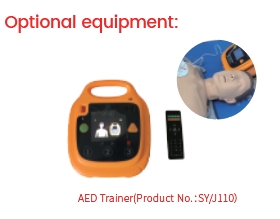
■ The simulated human is made of polymer materials, which are environmentally friendly and pollution-free; The anatomical landmarks are obvious and can touch the nipples, ribs, sternum, and xiphoid process, making it easy to operate and locate.
■ Simulate the accurate anatomical position of the human head and neck, with the head able to swing left and right and rotate horizontally 180 degrees, making it easy to remove oral foreign objects.
■ Having a real mouth, teeth, epiglottis, and uvula, it is possible to perform tracheal intubation.
■ The eyeball adopts OLED simulation, with visible colored retina, black pupils, transparent crystals, and the ability to reflect light at any angle; In a dead state, the pupil dilates and the reflex to light disappears.
■ The carotid artery pulsation can be palpable, and in a state of death, the carotid artery pulsation disappears.
■ Cardiopulmonary resuscitation, execution standard: 2020 American Heart Association Cardiopulmonary Resuscitation and Cardiovascular Emergency Guidelines, supine position with head tilted back.
* Feasible chest compressions.
* There are three feasible methods to open the airway: lifting the chin, neck, and jaw with both hands.
* It is feasible to perform mouth to mouth artificial respiration or use a simple respirator to assist breathing, and effective artificial respiration can show chest undulations.

■ The first aid chain has multiple automatic reactions throughout the entire process, including tapping, assessing carotid artery awareness, opening the airway, gas entering the stomach, CPR, and other indicators.
■ There are two communication methods to choose between analog humans and computers: USB communication and wireless WIFI communication.
■ Electronic monitoring of multiple indicators throughout the process:
* Pressing section: Monitor the number of presses (multiple or few), pressing position (correct or incorrect), pressing depth (too large or too small), pressing frequency (correct or incorrect), pressing rebound, and displaying the interruption time of pressing
* Pressing operation waveform display: Real time display of pressing operation waveform, through which pressing depth, pressing frequency, pressing rebound situation, pressing interruption time, pressing position, etc. can be determined.
* Monitoring of Blowing Part: Blowing frequency (excessive or insufficient), tidal volume (excessive or insufficient), tidal time, and gas intake into the stomach.
* Blowing operation waveform display: Real time display of blowing operation waveform, through which the blowing volume, blowing cycle, and moisture time can be determined.
■ According to the operating standards of the 2020 American Heart Association Guidelines for Cardiopulmonary Resuscitation and Cardiovascular First Aid, cardiopulmonary resuscitation operations can be evaluated, and the operation meets the standards, simulating human resurrection; The operation did not meet the standards, resulting in simulated human death.
■ CPR simulation training: There are two operating modes, practice, assessment, and each mode can set its own training time, CPR cycle number, etc.
* Practice mode CPR, with specialized exercises available for pressing depth, pressing frequency, blowing, etc.
* The pressing frequency has a guiding prompt sound of 110 times per minute, and there are prompts for excessive or insufficient pressing. Blowing too much, too little, and the sound of gas entering the stomach.
* Assessment Mode: Examiners can customize parameters according to competition requirements and have the function of setting national competition standards with one click. Within the set assessment time, assessments will be conducted in a 30:2 ratio. The setting items include: competition time, CPR cycle times (used to select single or multiple person operations), correct ratio of pressing and blowing (determining the resurrection standard after emergency operations), standard range of tidal volume and pressing depth.









